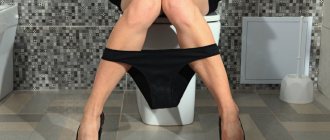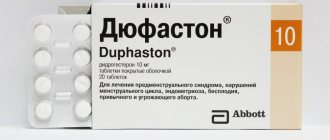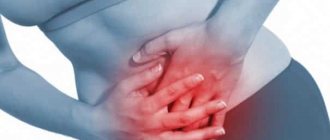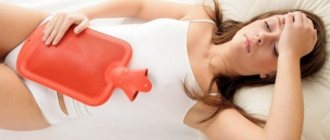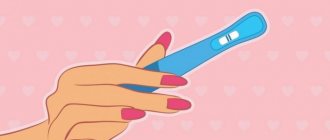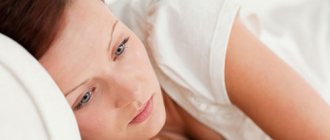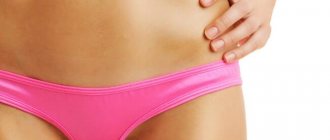Does No-shpa help with menstrual and menstrual pain?
Menstruation is often accompanied not only by bleeding, but also by unpleasant painful sensations of a spasmodic nature in the lower abdomen. Pain occurs when the uterus contracts, when it pushes out the endometrium and bloody discharge. Sometimes it is impossible to endure such discomfort, so girls look for painkillers. No-spa during menstruation is one of the most suitable options, since this drug is an antispasmodic and effectively eliminates pain.
How much should you drink noshpa during menstruation?
According to statistics, about 70% of women of childbearing age suffer from painful periods.
For some of them, menstruation simply throws them out of their usual rut, depriving them of the opportunity to work, participate in family life, or play sports. In such a situation, many women take the drug No-shpa.
What is the cause of painful menstruation, and how to take this medicine correctly so that the treatment does not cause harm?
What is menstrual pain
Doctors call painful menstruation the term algomenorrhea. If at the same time they are also irregular, then this condition is designated as algodismenorrhea. Almost three out of four women note that a few hours before the start of their next menstruation and in the first 1-2 days they experience nagging pain in the lower abdomen.
Such pain has a cramping nature: it intensifies or weakens within a few minutes. Lying on your side with your knees pulled up to your chest can reduce the intensity of pain, but does not eliminate it completely.
In addition to pain, women may experience nausea, sometimes even vomiting, loose stools, headaches, and weakness. Some experience a sharp drop in pressure, which leads to a collapsed state, sometimes to loss of consciousness.
Some ladies feel the need to eat everything they have in the refrigerator, while others, on the contrary, completely lose their appetite. This condition is complemented by anxiety, nervousness and sleep disturbances.
Causes of pain
The condition can be congenital, that is, appear immediately after the debut of menstruation, or develop during the first three years after its onset. This is the so-called primary algomenorrhea. It can also occur secondarily, as a result of various hormonal imbalances, gynecological diseases, and complications of surgical interventions.
Primary algomenorrhea develops as a result of the accumulation of menstrual blood in the uterine cavity. This leads to spastic contraction of the smooth muscles of the uterus and the appearance of local ischemia.
Another reason is a violation of prostaglandin synthesis, leading to endocrine disruption. The second fact explains all the variety of symptoms in addition to pain in the lower abdomen.
An additional risk factor is the presence of pathology in the structure of the uterus, its incorrect position (most often retrograde), as well as the presence of an intrauterine device.
Secondary algomenorrhea occurs after inflammatory diseases of the uterus (endometritis), curettage of its cavity in the past, in the presence of myomatous nodes, endometriosis, etc.
Secondary algomenorrhea may be a manifestation of a mental disorder or disease. It is more common in women who are emotionally labile, have suicidal thoughts, suffer from depression, have eating disorders, are sexually dissatisfied in marriage, or are unmarried.
Painful periods are serious. Sometimes they can be the first symptom indicating a problem in a woman’s body. Therefore, if you have algomenorrhea, you should definitely see a gynecologist and undergo a full examination.
Degrees of algomenorrhea
There are three main degrees of algomenorrhea, which directly depend on the severity of the manifestation of unpleasant symptoms.
It is characterized by slight unpleasant sensations in the lower abdomen of a pulling nature, accompanied by malaise. They do not lead to malfunction. As a rule, women do not resort to special medications.
It manifests itself as severe pain in the lower abdomen, which is accompanied by nausea, loose stools, frequent urination, sleep disturbance, depression, and increased sensitivity to sound and olfactory stimuli.
This condition affects a woman’s quality of life; in the first or second day from the start of menstruation, she has difficulty working and caring for children.
Pain in the lower abdomen and lumbar region is intense, cramping, forcing the woman to constantly stay in bed. They are accompanied by nausea, vomiting, diarrhea, drop in blood pressure and fainting.
As a rule, this is typical for women with congenital pathology of the uterus.
No-spa for pain during menstruation
One of the most popular drugs that helps to quickly cope with unpleasant symptoms is No-shpa. The peculiarity of drotaverine, which is included in its composition, is that it relaxes the smooth muscles of various organs, including the uterus. It relieves spasm, normalizes blood flow, as a result of which the painful condition gradually goes away.
One tablet contains 40 mg of drotaverine hydrochloride. The permissible dose is to take no more than 6 tablets per day. The drug also exists in the form of injections: a 2 ml ampoule, like a tablet, contains 40 mg of drotaverine.
The most common side effect of No-Spa is a sharp drop in blood pressure, which can lead to collapse or loss of consciousness. Therefore, the injection should be done in a horizontal position.
In addition, allergic reactions may develop (itching rash, swelling of the face, neck, chest or limbs), if they occur, you should immediately take an antihistamine and call an ambulance.
Facts about the drug No-shpa
The drug No-shpa is an over-the-counter drug, that is, in order to buy it you do not need to go to the doctor. In fact, a woman should still consult a gynecologist to find out the cause of algomenorrhea, because this disorder can be a symptom of a serious illness.
The drug No-shpa is included in the List of Vital and Essential Medicines (VED), therefore its price is controlled by the Government of the Russian Federation.
No-spa can enhance the effect of antiparkinsonian drugs, sleeping pills and other antispasmodics.
The medicine affects the nervous system, causing slight sedation. For this reason, female drivers and those whose work requires increased concentration and coordination of movement should be very careful when taking No-shpa.
Menstruation is often accompanied not only by bleeding, but also by unpleasant painful sensations of a spasmodic nature in the lower abdomen.
Pain occurs when the uterus contracts, when it pushes out the endometrium and bloody discharge. Sometimes it is impossible to endure such discomfort, so girls look for painkillers.
No-spa during menstruation is one of the most suitable options, since this drug is an antispasmodic and effectively eliminates pain.
No-spa for painful periods
Pain in the lower abdomen most often has a spasmodic nature; it occurs when the smooth muscles of the uterus contract, when it removes the endometrium, unfertilized egg and bloody discharge from damaged vessels.
Excitation of smooth muscles occurs much more slowly than in striated muscles, but it leads to a longer-lasting effect, that is, the muscles remain in the contraction phase longer.
It is this physiological feature of the muscle tissue of the uterus that provokes painful sensations.
Having briefly studied the cause of the pain that accompanies menstruation, it is easy to understand why a conventional analgesic (for example, Analgin or Baralgin) does not help - its mechanism of action is based on reducing the activity of prostaglandins - substances that cause inflammation and pain, while such drugs do not relieve muscle spasms. Another class of painkillers, which includes No-shpa, has an antispasmodic effect.
Source: https://ginekologiya-urologiya.ru/menstruaciya/skolko-nado-pit-noshpy-pri-mesyachnyh
Peculiarities
Discomfort occurs due to the fact that the uterus gets rid of unfertilized eggs through contractions of muscle tissue. Sometimes the spasms take longer, which means the illness is more serious.
The active component of the drug is drotaverine. It helps relax muscle tissue and blood vessels, and as a result, spasms become much weaker. Additionally, this drug fights prostaglandins, which release damaged tissue and can cause inflammation.
No-spa dilates blood vessels, reduces muscle tone and reduces the sensitivity of internal organs. The advantages of No-shpa also include the fact that it does not have a negative effect on the central nervous system.
No-shpa effect
No-shpa, an antispasmodic that can relax vascular muscle tissue and smooth muscles, will help you cope with painful sensations during menstruation. Due to the active component - drotaverine hydrochloride - the drug gently relieves spasms of the uterine muscles, so within 15-20 minutes after its use the girl will be able to feel relief from discomfort. No-spa copes not only with a single muscle tightening, it temporarily prevents further long-term contractions.
No-spa not only has antispasmodic activity, this medicine partially neutralizes the effect of prostaglandins - substances that are synthesized and released into the bloodstream when body tissues are damaged. Such compounds have one unpleasant effect - they cause an inflammatory reaction accompanied by pain.
When the endometrium is damaged, a lot of prostaglandins are released, they increase the pain from uterine spasms. No-spa partially reduces the body's sensitivity to prostaglandins, so the discomfort goes away.
Does No-Shpa help with menstruation?
According to statistics, No-Shpa is the most used drug for menstrual pain. Regardless of the fact that there are more expensive or cheaper analogues, women are accustomed to using this drug in the first days of menstruation. Once inside the body, No-Shpa affects the smooth muscles of the uterus, eliminating spasms.
How long does it take for No-Shpa to work during menstruation?
Small yellow rounds with the characteristic inscription “SPA” have long become an integral part of the first aid kit of every woman of reproductive age. The drug helps get rid of cramps and pain in the lower abdomen. If we compare No-Shpu and the drug Papaverine, the effect of the first drug occurs faster, which is why they are chosen by millions of women around the world.
⚡ No-Spa is quickly absorbed when entering the body. It is necessary to drink No-Shpa with plenty of water.
No-Shpa is highly bioavailable, its half-absorption period is 12 minutes. Taking No-Shpa orally, a woman can expect its effect within 15 minutes. If the drug is administered intravenously, its effect is noticeable 5 minutes after administration. Thanks to this quick effect, a woman can take the medicine at the first urge of cramps in order to easily survive the onset of her period.
Drotaverine and No-Shpa - what is the difference
When the muscles begin to contract sharply, a spasm is formed, causing unbearable pain. Every woman feels this kind of pain during menstruation. In such cases, antispasmodic drugs, for example, No-Shpa or Drotaverine, come to the rescue. Before purchasing the listed medications at the pharmacy, you need to find out how they differ.
Drotaverine hydrochloride is an active substance that is present in No-Shpa and Drotaverine. This element increases blood flow to organs, lowers blood pressure and has an antispasmodic effect. From this we can conclude that both medicines contain the same substance, which helps with menstrual pain.
The difference between No-Shpa and Drotaverine is in one indicator - their cost. No-Shpa, as a more advertised brand, has a higher value than Drotaverine. The dosage of these medications is also the same, so if the pharmacy does not have No-Shpa, you can safely buy Drotaverine to eliminate pain during menstruation. You can learn more about Drotaverine from the video:
Methods of using No-shpa for menstrual and menstrual pain
The dosage of No-shpa for painful periods is 120-240 mg per day. This dose must be divided and taken 2-3 times. In this case, a single dose should not exceed 80 mg. However, if a woman has low body weight, she may take less of the medicine.
